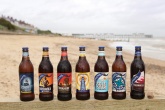Glass: Take the weight off
Glass was the first material to be recycled on a mass scale in the UK – bottle banks have been a common feature of British towns and cities since the 1970s – and a long-established recycling infrastructure has meant that ‘new’ bottles made in the UK can contain up to 90 per cent recycled material.
Whilst its recyclability is beyond dispute, in the last decade or so, there have been moves to make glass go even further by reducing the average weight of containers, or ‘lightweighting’. The idea is that this uses less material and less energy and thus reduces the environmental impact.

Lightweighting’s turning point was the launch of the first Courtauld Commitment in 2005, when manufacturers first agreed to reduce packaging and improve resource efficiency within the UK grocery sector. In its wake, between 2006 and 2008, WRAP ran the Container Lite programme, which aimed to reduce waste glass through demonstrator projects showing how weight reductions can be achieved. Running parallel to this was Glass Rite, a British Glass/WRAP co-project that brought together producers, retailers and bottle manufacturers to encourage lightweighting in the wine industry. During those two years, more than 300 wine labels converted to lighter bottles.
The project boasted some significant successes. Kingsland, one of the UK’s largest wine suppliers, reduced its 650-gramme (g) bottle down to 484g and its 460g bottle to 400g, a move that saved the company more than 1,600 tonnes of glass and 1,140 tonnes of CO2 per year. Glass Rite also had an effect on the way wine was transported. Rebecca Cocking, Head of Container Affairs at British Glass, explains: “I know of one company who thought, ‘Hang on – we’re shipping wine from Australia to the UK in heavyweight bottles. Is there any way we can do it in a more environmentally-friendly Glass has plenty of attributes that make it ideal for packaging some types of product, though its heavy weight isn’t necessarily one of them. Will Simpson investigates the modern phenomenon of lightweighting and discovers just how low glass could goway?’ So, they began to import in bulk and then bottled – using lightweight containers – in the UK. They saved not only on the lightweighting but also transportation costs.”
Beyond commercial considerations, the other main driver in the rise in lightweighting has been technology. As Fiacre O’Donnell, Head of Strategic Development at UK Glass Manufacturer Encirc, explains, the main breakthrough here has been the emergence of what is known as ‘narrow neck press and blow’ (NNPB) technology to make the bottles. Traditionally, glasses have been made through a process known as ‘blow blow’ (BB), whereby, in O’Donnell’s words: “The gob of glass is delivered into the blank mould. In the BB process, air is used to compact the glass down into the blank mould forming the finish on the bottle (screw threads, cork or whatever). The blank is then transferred into the blow side where the bottle is blown up to its final shape.”
O’Donnell continues that, with NNPB, the second half of the process is the same, but in the first half, the ‘gob’ is displaced with a plunger in the mould, rather than being blown. He continues: “NNPB allows you to get an even distribution of glass. That means that whenever you make the bottle, the wall of thickness on every part of the bottle is consistent. A lovely consistent walled thickness gives the container strength. But you have to have a skilled workforce to do this... ‘Blow blow’ lets you compensate because [the bottles] are heavier. You’ve got a wee bit more tolerance on them. With NNPB you have minimum amount of tolerance on the bottle, so your operators have to really know what they’re doing.”
For drinks manufacturers, lightweighting has certainly resulted in savings. Simon Gilleard, Packaging Development Manager from AB In-Bev, the brewing and beverage multinational, suggests that a mere 10g reduction in the 30-centilitre Budweiser bottle it manufactures has resulted in a saving of 3,250 tonnes of material per year. “You’re not just using less raw materials, you’re also saving on things like energy consumption in the conservation process and on logistics for both empty and finished goods like less fuel consumption.”
So, if there are huge benefits in terms of savings, especially of raw materials, why, you might ask, aren’t all bottles being lightweighted? Well, there are certain physical restrictions on how light you can go – the nature of what’s contained in the bottle being one crucial one. “If you’ve something that is carbonated, then obviously you’ve got to have a certain amount of thickness”, explains Cocking. “You don’t want something that could easily blow or shatter because of the internal pressure. The more carbonated... a drink is, the heavier the container needs to be.”

But the biggest barrier, she suggests, could be a psychological one. “If you take a premium spirit, there is a perception from a consumer point of view that a heavier bottle means it’s more prestigious – it’s got that ‘premier’ feel. Therefore, there are some concerns that if you take the weight out to the point where people ask, ‘Is this glass or is this plastic?’ they may feel it’s an inferior product.”
Furthermore, even if we are becoming accustomed to lighter bottles in Europe, businesses can sometimes be reluctant to rollout lighter bottles across the global market: “You’ve got to look at it from a manufacturer’s point of view”, says Cocking. “It’s not as easy as saying, ‘Yes, we’ll do them all.’ Say you’re a whisky manufacturer – it could be the majority of your bottles are not even sold in the UK. Even if in the UK, we all say, ‘Yeah, fine, we’ll take Bell’s in a lightweight container’, the Asian market might refuse it because lightweight to them is saying, ‘This is cheap, this is nasty.’”
 This article was taken from Issue 86
This article was taken from Issue 86Lightweighting also brings up a thorny issue for the glass producers. Glass is heavily dependent on the recycled material it receives, the cullet, to give it its proper name. The problem is that the lightweighting process places a higher premium on the quality of the recycled cullet, at a time when its quality, due to the increasingly co-mingled nature of UK recycling, is declining. O’Donnell explains: “Even a little piece of contamination – be it metal or ceramic or whatever – will have a hugely detrimental effect on a lightweight container, whereas you can more easily get away with it in a heavier container. Whilst we are challenging ourselves as an industry to reduce the weight of our containers, we’re being restricted somewhat by government policy in allowing material to be co-mingled.” At present, 1.6 million tonnes of glass is collected every year, but only 600,000 tonnes of that goes back into producing new glass. “It’s a big concern for us”, O’Donnell admits.
Assuming these barriers can be overcome, how far can lightweighting go? In 2015, Adnams claimed to have produced the lightest ever ale bottle – a 500-millilitre (ml) bottle that, prior to its first round of lightweighting in 2007, was over 450g, but was reduced initially to 299g and then last year to a mere 280g. “I think it would be tough to go further”, says Ben Orchard, Adnams’s Environmental Sustainability Manager. “Especially when you consider what the bottle has to go through – structural rigidity and health and safety wise. I would like to think we can go lower, but we are probably pushing the limits.”
Gilleard, though, is keeping an open mind. “I wouldn’t like to say how far it can go. If you look at the trends, it just keeps going. The opportunities are ongoing and we are continually seeing developments from suppliers and benchmarking internally and externally for ways to improve further. There may be breakthrough technologies coming through to help and take lightweighting even further – this could be anything from supplier capability through to internal processes around bottle handling.”
Whether glass can go any lighter remains to be seen, but the days of carting heavyweight bottles back from the supermarket or off licence would appear to be numbered. 





